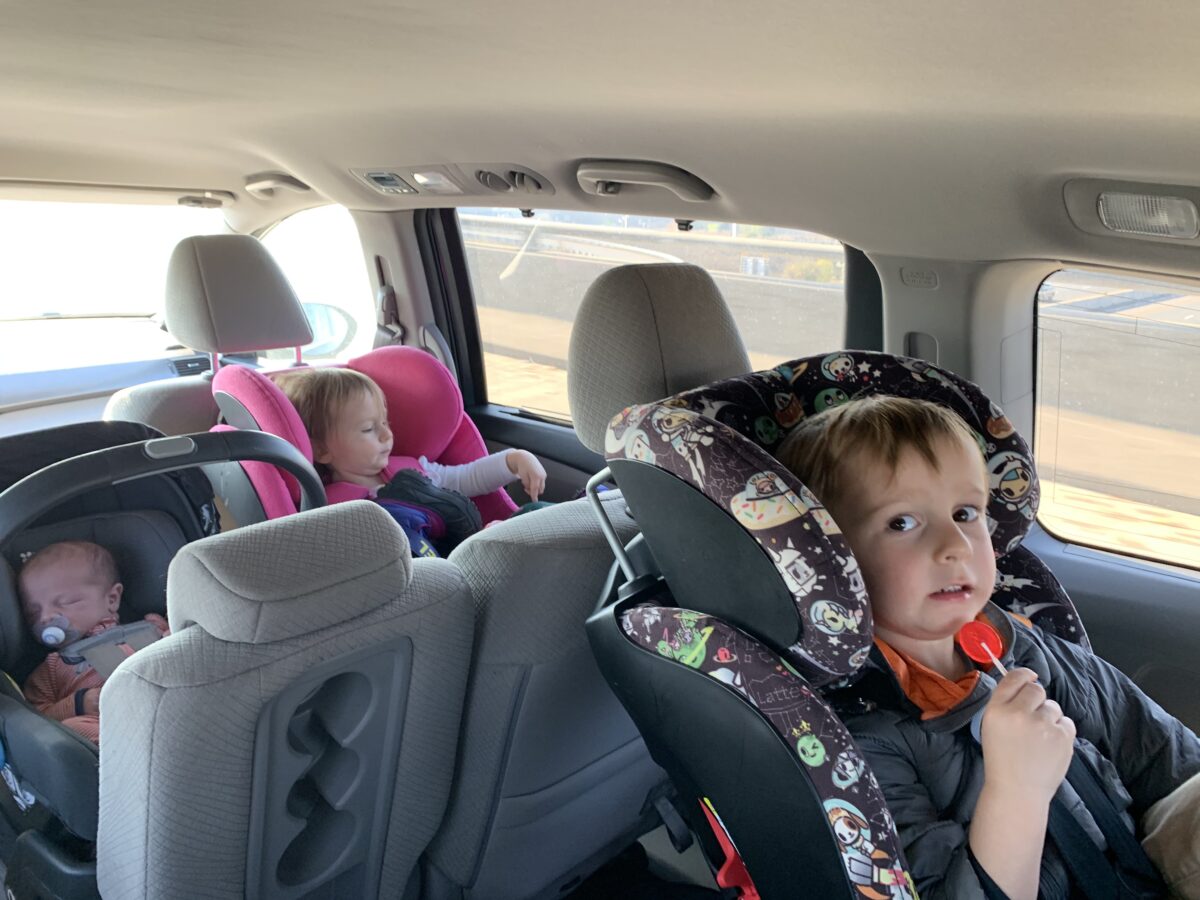When Should I Stop Using My Baby’s Bucket Seat?

When you were an expecting parent or caregiver-to-be, you may have found the process of purchasing your infant’s bucket seat simple. Though there are many options to choose from in this category, they all seem to look the same, and you might have found yourself making the choice based on your stroller’s compatibility or budget rather than whether or not it was the best option for your vehicle. You also didn’t have to consider whether they would be rear-facing or front-facing in their seat as all infant seats are rear-facing, easy-peasy!
Now that you’ve got some parenting experience under your belt and your bundle of joy is growing into an active (and heavy) baby, you might find yourself wondering if it is time to ditch the bucket seat in favour of the next step a convertible car seat. But when is the best time to switch to a convertible car seat? Though a too-heavy to-move seat might be a sign your days with the bucket seat are done, there are a few other factors you need to keep in mind.
At Seated Safely, we strive to empower parents and caregivers to make safety-oriented decisions when it comes to car seats. We understand that knowing which car seat is best can be hard for parents to determine on their own; that’s why we are always here to offer support. In this post, we outline the basics of convertible car seats and offer some guidance in choosing the best seat for your family’s needs.
Need help with car seat installation or have questions about choosing your next seat? Connect with Seated Safely. We are the Durham Region CPST you can rely on to provide you with judgment-free support.
When Is an Infant Seat Outgrown?
If you are getting tired of lugging around a clunky, heavy car seat everywhere you go, you might be wondering, when can I stop using a bucket car seat? The first step to help you determine when it’s time to stop is your car seat manual. Every car seat manual will detail how to install and use the seat properly. Always read your car seat manual. It includes important information such as when the seat is outgrown when provided items such as infant padding need to be removed, and how to use a car seat UAS system.
Your infant car seat is outgrown when the baby has reached either the height or weight limit that is specified by the car seat manufacturer or when their head is 1” from the shell of the seat. Sometimes this means that a child will grow out of the seat well before the height or weight limit has been reached. Keep an eye on these requirements, and you should have a good idea of when it is time to switch to your next seat.
If you are finding that your baby’s bucket seat is too heavy to take in and out of your vehicle, but they are still a while away from outgrowing the seat, consider leaving the seat in the vehicle. You do not have to take your bucket seat out of the vehicle every time you use it. Instead, keep the seat in place and simply take your baby in and out.
What is a Convertible Car Seat?
A convertible car seat is a car seat that can be used in both rear-facing and forward-facing positions. Some parents think of these as their child’s “big seat,” or step-two seat. There are many varieties of convertible car seats on the market, and some are able to accommodate a child from birth to booster. Your convertible car seat will usually seem much larger than your bucket seat though they often take up a similar footprint in your vehicle, particularly when used rear-facing. For this reason, it is important to choose a seat based that will fit your child well, can be installed safely within your vehicle and is able to be used properly by you and other caregivers properly every time.
Examples of convertible car seats include the following seats. Please note that these seats may or may not be right for your needs, click here or keep reading to learn more about how to choose a seat for your child.
How Can I Know Which Convertible Seat to Buy?
There are many factors at play when it comes to choosing the right convertible car seat for your baby. Though it may seem like choosing a seat is as simple as finding one you like and buying it, you’ll want to consider a few things to ensure you make the best choice.
Your Child – how your child fits in a seat and their comfort are important. Sometimes children who are on either the high or low end of percentile charts may not fit in a seat that other parents think is perfect. If your child suffers from issues with reflux or is prone to motion sickness, it may also be working considering a seat that is more “L” shaped rather than “C” shaped. The Clek Foonf and Graco Contender are two examples of “L” shaped seats to help you visualize what this style of the seat looks like. A Child Passenger Safety Technician can also offer support in helping you choose a “C” or “L” shaped seat.
Your Vehicle – did you know that not every car seat works well in every vehicle? Sometimes a seat is simply too large to fit into a vehicle and makes it unsafe for a front passenger to sit in their seat. Other times, the vehicle seat’s bight makes it impossible to achieve the correct recline position for your child. When it’s time to move to front facing, fixed headrests may also interfere with a proper install. There are many considerations to look into. A CPST near me might be your best bet when looking for support with knowing which seat is suitable for your car.
Your Budget – have you ever assumed that the most expensive car seat available must be the best one? You wouldn’t be the first to think it, but you might be happy to learn that in Canada, all car seats pass the same safety test. This means that when installed and used properly, your seat is safe! Choose a seat that suits your budget, and don’t worry about not having the “best” seat. You can keep your child safe in a car seat within any budget.
Your Rear-Facing Goals – rear-facing for as long as possible is a great goal to have and is one that will keep your child safer for longer. Though there are many reasons why a child may need to move to front facing before they max their seat, it is recommended by CPSTs and medical professionals that children stay rear-facing until they reach the height or weight limit of their seat whichever comes first. If your child is in a higher percentile range of growth, you might want to consider a seat that allows for extended rear-facing such as Evenflow Everystage DLX, which can accommodate a child rear-facing until 50lbs.
Your Ability to Install and Use the Seat – if you cannot install your seat properly or use it correctly every time, it is not the seat for you. Some parents and caregivers find that their car seat is too difficult to tighten and may be tempted to think a too-loose harness is “good enough.” Take care in choosing a seat that you feel confident using every time. For tough buckles, also consider using the UnbuckleMe tool to make your life or the life of a caregiver easier.
Choosing a car seat can be tough, especially now that you know it’s not as easy as finding a colour or style that you like. Vancouver Island Car Seat Technicians has compiled a list of seats that are often recommended by car seat technicians. You may also wish to find a car seat tech near you for personalized support.
Should I Choose a Convertible Seat that Turns into a Booster Seat?
Many car seat manufacturers advertise the ability to go from birth to booster in a seemingly seamless process. Though these seats are all safe when installed and used correctly, there is no guarantee that each stage will work well for your child. Every child’s body is unique, and though a seat may have been fantastic as a rear-facing seat for years, it might not make a suitable booster for your child. These seats might be a great choice, but if you are looking to stay within a specific budget, there may be no need to splurge on these long-lasting seats upfront. Know that booster seats are often very affordable, and it could be a smart choice to wait and see how your child grows before assuming you will use the booster option that your convertible seat provides.
When Should I Switch My Child to Front Facing?
As a Child Passenger Safety Technician, Seated Safely will always encourage parents and caregivers to keep their children rear-facing for as long as possible. We understand that parents may be worried about long legs (not a problem), motion sickness, wanting to keep their kids entertained in their seats and other issues such as too little room for other passengers. As a parent or caregiver, you are best equipped to make the right choice for your family. However, you will always need to follow the minimum requirements for front-facing according to local regulations and your car seat manual. Consider booking a caregiver information session to discuss your unique concerns and allow us to help you find a way to keep your child as safe as possible for as long as possible.
Who Can Help Me Ensure My Seat is Installed Correctly?
If you live in Durham Region (Pickering, Ajax, Whitby, Oshawa, Clarington) and are looking for a CPST near me, Seated Safely can help. There are hundreds of CPSTs’ across Canada who are passionate about helping parents and caregivers install and use their car seats properly. Find a local CPST by searching the CPSAC directory and take steps towards keeping your child safer in their car seat.
*Amazon links in this article are affiliate links. Your choice to purchase through these links is greatly appreciated.
